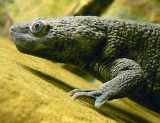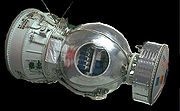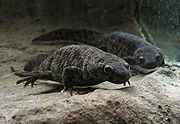
Iberian Ribbed Newt
Encyclopedia
The Iberian ribbed newt or Spanish ribbed newt (Pleurodeles waltl) is a newt
endemic to the central and southern Iberian Peninsula
and Morocco
. It is known for its sharp ribs which can puncture through its sides, and as such is also called the sharp-ribbed newt.
s running down each side. Through these, its sharp ribs can puncture. The ribs act as a defense mechanism, causing little harm to the newt. In the wild this amphibian grows up to 30 centimetres (11.8 in), but rarely more than 20 centimetres (7.9 in) in captivity. Its color is dark gray dorsally, and lighter gray on its ventral side, with rust-colored small spots where its ribs can protrude. These newts have a flat spade-shaped head and a long tail which is about half their body length. Males are slenderer and usually smaller than females. The larvae have bushy external gills and usually paler color patterns than the adults.
P. waltl is far more aquatic-dwelling than other European tailed amphibians. Even though they are quite able to walk on land, most rarely leave the water, living usually in ponds, cisterns and ancient village wells that were common in Portugal
and Spain
in the past. They prefer cool, quiet and deep waters, where they feed on insects, worms and tadpoles.
Hormones play an important role during the sex determination process, and the newts can be manipulated to change sex by adding hormones or hormone-inhibitors to the water they are reared in.
Aromatase
, an estrogen
-synthesizing enzyme
which acts as a steroid
hormone, plays a key role in sex determination in many non-mammalian vertebrate
s including the Iberian Ribbed Newt. It is found in higher levels in the gonad–mesonephros complexes in ZW larvae than in their ZZ counterparts, although not in heat-treated ZW larvae. The increase occurs near the final stages of which their sex can be determined by temperature (stage 52).
in its 2006 Red List. It received this listing because its wild populations appear to be in significant decline due to widespread habitat loss and the effects of invasive species, thus making the species close to qualifying for Vulnerable
. Previously, in 2004, the species had been listed as Least Concern
, the lowest ranking. This species is generally threatened through loss of aquatic habitats through drainage, agrochemical pollution, the impacts of livestock (in North African dayas), eutrophication
, domestic and industrial contamination, golf courses, and infrastructure development. It has largely disappeared from coastal areas in Iberia and Morocco close to concentrations of tourism and highly populated areas (such as Madrid
's outskirts). Introduced fish and crayfish (Procambarus clarkii
) are known to prey on the eggs and larvae of this species, and are implicated in its decline. Mortality on roads has been reported to be a serious threat to some populations.
 Pleurodeles waltl has been studied in space on at least six missions. The first Iberian Ribbed Newts in space may have been in 1985 on board Bion 7
Pleurodeles waltl has been studied in space on at least six missions. The first Iberian Ribbed Newts in space may have been in 1985 on board Bion 7
. The ten newts shared their journey with two Rhesus Macaque
s and ten rats, in an otherwise crewless Soviet
Cosmos satellite. In 1992, Bion 10
also carried the newts on board, as did Bion 11
in 1996.
P. waltl research was continued later in 1996 by French
-led experiments on the Mir space station (Mir Cassiopée expedition), with follow-up studies in 1998 (Mir Pégase expedition) and 1999 (Mir Perseus expedition). Foton-M2
also carried the Iberian Ribbed Newt in 2005.
 The newts were chosen because they are a good model organism
The newts were chosen because they are a good model organism
for the study of microgravity. They are a good model organism because of the female's ability to retain live sperm in her cloaca
for up to 5 months, allowing her to be inseminated on Earth, and later (in space) have fertilisation induced through hormonal stimulation. Another advantage to this species is that development is slow, so all the key stages of ontogenesis can be observed: from the oocyte
to swimming tailbud embryos or larvae.
Studies looked at the newts' ability to regenerate (which was faster in space overall, and up to two times in early stages), as well as the stages of development and reproduction in space.
On the ground, studies of hypergravity
(up to 3g
) on P. waltl fertilisation have also been conducted, as well as on the fertility of the space-born newts once they arrived back on Earth (they were fertile, and without problems).
Other amphibian species to travel in space include the newt species Lissotriton vulgaris and Cynops pyrrhogaster, and frog species: African clawed frog
, Japanese tree frog
, and several frogs in the Rana genus: Rana pipiens, Rana calestiana and Rana temporaria.
Newt
A newt is an aquatic amphibian of the family Salamandridae, although not all aquatic salamanders are considered newts. Newts are classified in the subfamily Pleurodelinae of the family Salamandridae, and are found in North America, Europe and Asia...
endemic to the central and southern Iberian Peninsula
Iberian Peninsula
The Iberian Peninsula , sometimes called Iberia, is located in the extreme southwest of Europe and includes the modern-day sovereign states of Spain, Portugal and Andorra, as well as the British Overseas Territory of Gibraltar...
and Morocco
Morocco
Morocco , officially the Kingdom of Morocco , is a country located in North Africa. It has a population of more than 32 million and an area of 710,850 km², and also primarily administers the disputed region of the Western Sahara...
. It is known for its sharp ribs which can puncture through its sides, and as such is also called the sharp-ribbed newt.
Physical description
The Iberian Ribbed Newt has tubercleTubercle
A tubercle is generally a wart-like projection, but it has slightly different meaning depending on which family of plants or animals it is used to refer to....
s running down each side. Through these, its sharp ribs can puncture. The ribs act as a defense mechanism, causing little harm to the newt. In the wild this amphibian grows up to 30 centimetres (11.8 in), but rarely more than 20 centimetres (7.9 in) in captivity. Its color is dark gray dorsally, and lighter gray on its ventral side, with rust-colored small spots where its ribs can protrude. These newts have a flat spade-shaped head and a long tail which is about half their body length. Males are slenderer and usually smaller than females. The larvae have bushy external gills and usually paler color patterns than the adults.
P. waltl is far more aquatic-dwelling than other European tailed amphibians. Even though they are quite able to walk on land, most rarely leave the water, living usually in ponds, cisterns and ancient village wells that were common in Portugal
Portugal
Portugal , officially the Portuguese Republic is a country situated in southwestern Europe on the Iberian Peninsula. Portugal is the westernmost country of Europe, and is bordered by the Atlantic Ocean to the West and South and by Spain to the North and East. The Atlantic archipelagos of the...
and Spain
Spain
Spain , officially the Kingdom of Spain languages]] under the European Charter for Regional or Minority Languages. In each of these, Spain's official name is as follows:;;;;;;), is a country and member state of the European Union located in southwestern Europe on the Iberian Peninsula...
in the past. They prefer cool, quiet and deep waters, where they feed on insects, worms and tadpoles.
Sex determination
Sex determination is regulated by sex chromosomes, but can be overridden by temperature. Females have both sex chromosomes (Z and W), while males have two copies of the Z chromosome (ZZ). However, when ZW larvae are reared at 32 °C (90 °F) during a particular stages of development (stage 42 to stage 54), they differentiate into functional neomales.Hormones play an important role during the sex determination process, and the newts can be manipulated to change sex by adding hormones or hormone-inhibitors to the water they are reared in.
Aromatase
Aromatase
Aromatase is an enzyme responsible for a key step in the biosynthesis of estrogens. It is a member of the cytochrome P450 superfamily , which are monooxygenases that catalyze many reactions involved in steroidogenesis. In particular, aromatase is responsible for the aromatization of androgens into...
, an estrogen
Estrogen
Estrogens , oestrogens , or œstrogens, are a group of compounds named for their importance in the estrous cycle of humans and other animals. They are the primary female sex hormones. Natural estrogens are steroid hormones, while some synthetic ones are non-steroidal...
-synthesizing enzyme
Enzyme
Enzymes are proteins that catalyze chemical reactions. In enzymatic reactions, the molecules at the beginning of the process, called substrates, are converted into different molecules, called products. Almost all chemical reactions in a biological cell need enzymes in order to occur at rates...
which acts as a steroid
Steroid
A steroid is a type of organic compound that contains a characteristic arrangement of four cycloalkane rings that are joined to each other. Examples of steroids include the dietary fat cholesterol, the sex hormones estradiol and testosterone, and the anti-inflammatory drug dexamethasone.The core...
hormone, plays a key role in sex determination in many non-mammalian vertebrate
Vertebrate
Vertebrates are animals that are members of the subphylum Vertebrata . Vertebrates are the largest group of chordates, with currently about 58,000 species described. Vertebrates include the jawless fishes, bony fishes, sharks and rays, amphibians, reptiles, mammals, and birds...
s including the Iberian Ribbed Newt. It is found in higher levels in the gonad–mesonephros complexes in ZW larvae than in their ZZ counterparts, although not in heat-treated ZW larvae. The increase occurs near the final stages of which their sex can be determined by temperature (stage 52).
Conservation
The IUCN listed the Iberian Ribbed Newt as Near ThreatenedNear Threatened
Near Threatened is a conservation status assigned to species or lower taxa that may be considered threatened with extinction in the near future, although it does not currently qualify for the threatened status...
in its 2006 Red List. It received this listing because its wild populations appear to be in significant decline due to widespread habitat loss and the effects of invasive species, thus making the species close to qualifying for Vulnerable
Vulnerable species
On 30 January 2010, the IUCN Red List of Threatened Species identified 9694 Vulnerable species, subspecies and varieties, stocks and sub-populations.-References:...
. Previously, in 2004, the species had been listed as Least Concern
Least Concern
Least Concern is an IUCN category assigned to extant taxon or lower taxa which have been evaluated but do not qualify for any other category. As such they do not qualify as threatened, Near Threatened, or Conservation Dependent...
, the lowest ranking. This species is generally threatened through loss of aquatic habitats through drainage, agrochemical pollution, the impacts of livestock (in North African dayas), eutrophication
Eutrophication
Eutrophication or more precisely hypertrophication, is the movement of a body of water′s trophic status in the direction of increasing plant biomass, by the addition of artificial or natural substances, such as nitrates and phosphates, through fertilizers or sewage, to an aquatic system...
, domestic and industrial contamination, golf courses, and infrastructure development. It has largely disappeared from coastal areas in Iberia and Morocco close to concentrations of tourism and highly populated areas (such as Madrid
Madrid
Madrid is the capital and largest city of Spain. The population of the city is roughly 3.3 million and the entire population of the Madrid metropolitan area is calculated to be 6.271 million. It is the third largest city in the European Union, after London and Berlin, and its metropolitan...
's outskirts). Introduced fish and crayfish (Procambarus clarkii
Procambarus clarkii
Procambarus clarkii is a freshwater crayfish species, native to the Southeastern United States, but found also on other continents, where it is often an invasive pest. It is known variously as the red swamp crawfish, red swamp crayfish, Louisiana crawfish, Louisiana crayfish or mudbug.-Range and...
) are known to prey on the eggs and larvae of this species, and are implicated in its decline. Mortality on roads has been reported to be a serious threat to some populations.
Space experiments

Bion 7
Bion 7 was a biomedical research mission satellite involving scientists from nine countries. It was part of the Bion program.It carried two Rhesus monkeys named Gordyy and Oomka, ten male rats, and ten newts. The monkey research focused on vestibular and blood flow investigations as well as...
. The ten newts shared their journey with two Rhesus Macaque
Rhesus Macaque
The Rhesus macaque , also called the Rhesus monkey, is one of the best-known species of Old World monkeys. It is listed as Least Concern in the IUCN Red List of Threatened Species in view of its wide distribution, presumed large population, and its tolerance of a broad range of habitats...
s and ten rats, in an otherwise crewless Soviet
Soviet Union
The Soviet Union , officially the Union of Soviet Socialist Republics , was a constitutionally socialist state that existed in Eurasia between 1922 and 1991....
Cosmos satellite. In 1992, Bion 10
Bion 10
Bion 10 , a C.I.S. spacecraft, was launched by a Soyuz-U rocket from the Plesetsk Cosmodrome. It was part of the Bion program. It carried two monkeys and several insects, amphibians, plants, and cell cultures. Participating scientists were from nine countries and ESA...
also carried the newts on board, as did Bion 11
Bion 11
Bion 11 was a Russian space mission that was part of the Bion series of space flights. It carried newts, snails, Drosophila flies and other insects, bacteria, and two macaque monkeys , Lapik and Multik...
in 1996.
P. waltl research was continued later in 1996 by French
France
The French Republic , The French Republic , The French Republic , (commonly known as France , is a unitary semi-presidential republic in Western Europe with several overseas territories and islands located on other continents and in the Indian, Pacific, and Atlantic oceans. Metropolitan France...
-led experiments on the Mir space station (Mir Cassiopée expedition), with follow-up studies in 1998 (Mir Pégase expedition) and 1999 (Mir Perseus expedition). Foton-M2
Foton-M2
The Foton-M2 was a space mission aboard an unmanned Foton-M spacecraft carrying a mainly European payload by the European Space Agency . It was placed into orbit by a Russian Soyuz-U launcher on 20 June 2005 at 14:00 Central European Time from the Baikonur Cosmodrome in Kazakhstan by the Russian...
also carried the Iberian Ribbed Newt in 2005.

Model organism
A model organism is a non-human species that is extensively studied to understand particular biological phenomena, with the expectation that discoveries made in the organism model will provide insight into the workings of other organisms. Model organisms are in vivo models and are widely used to...
for the study of microgravity. They are a good model organism because of the female's ability to retain live sperm in her cloaca
Cloaca
In zoological anatomy, a cloaca is the posterior opening that serves as the only such opening for the intestinal, reproductive, and urinary tracts of certain animal species...
for up to 5 months, allowing her to be inseminated on Earth, and later (in space) have fertilisation induced through hormonal stimulation. Another advantage to this species is that development is slow, so all the key stages of ontogenesis can be observed: from the oocyte
Oocyte
An oocyte, ovocyte, or rarely ocyte, is a female gametocyte or germ cell involved in reproduction. In other words, it is an immature ovum, or egg cell. An oocyte is produced in the ovary during female gametogenesis. The female germ cells produce a primordial germ cell which undergoes a mitotic...
to swimming tailbud embryos or larvae.
Studies looked at the newts' ability to regenerate (which was faster in space overall, and up to two times in early stages), as well as the stages of development and reproduction in space.
On the ground, studies of hypergravity
Hypergravity
Hypergravity is defined as the condition where the force of gravity exceeds that on the surface of the earth. This is expressed as being greater than 1 g...
(up to 3g
G-force
The g-force associated with an object is its acceleration relative to free-fall. This acceleration experienced by an object is due to the vector sum of non-gravitational forces acting on an object free to move. The accelerations that are not produced by gravity are termed proper accelerations, and...
) on P. waltl fertilisation have also been conducted, as well as on the fertility of the space-born newts once they arrived back on Earth (they were fertile, and without problems).
Other amphibian species to travel in space include the newt species Lissotriton vulgaris and Cynops pyrrhogaster, and frog species: African clawed frog
African clawed frog
The African clawed frog is a species of South African aquatic frog of the genus Xenopus. Its name is derived from the three short claws on each hind foot, which it uses to tear apart its food...
, Japanese tree frog
Japanese Tree Frog
The Japanese tree frog is a species of tree frog belonging to the genus Hyla. The species is distributed from Hokkaidō to Yakushima in Japan and from Korea along the Ussuri River to northeastern China....
, and several frogs in the Rana genus: Rana pipiens, Rana calestiana and Rana temporaria.

